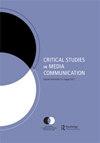Craig Of the Creek: Black childhood and environmental racism
IF 1.5
2区 文学
Q3 COMMUNICATION
引用次数: 0
Abstract
ABSTRACT The animated show Craig of the Creek is an important source of animated environmental imagery for children as its main characters and plot provide the opportunity to discuss both race and environmental issues. However, these shows often only show one view of environmental degradation and ignore issues like environmental racism and urban housing issues. The history of racial environmental innocence and the exclusion of people of color need to be considered to fully understand the benefits and shortcomings of the show’s narrative. I argue that while Craig of the Creek resists some notions of racial innocence, the show still promotes a mainly romanticized, commodified view of nature. To do this, I provide a close ecocritical analysis utilizing discourse analysis and environmental racism theory to explain how well the show includes social inequality. I conclude that while the cartoon acknowledges pollution and the dangers of nature, it largely ignores the complicated relationship between race and the environment and reproduces the idea of the environment being nothing more than a commodity. It glosses over the complicated history that both people of color and indigenous people have with nature ownership and is passing on an unfortunate lesson to children viewing the program.《溪中的克雷格:黑人童年与环境种族主义》
动画片《小溪里的克雷格》是儿童动画环境意象的重要来源,因为它的主要人物和情节提供了讨论种族和环境问题的机会。然而,这些节目往往只展示了环境退化的一种观点,而忽视了环境种族主义和城市住房问题等问题。种族环境的清白和有色人种被排斥的历史需要被考虑,以充分理解该剧叙事的优点和缺点。我认为,虽然《克里克的克雷格》抵制了一些种族清白的观念,但这部剧仍然宣扬了一种主要是浪漫化的、商品化的自然观。为了做到这一点,我利用话语分析和环境种族主义理论提供了一个密切的生态批评分析,以解释该节目如何很好地包括社会不平等。我的结论是,虽然这幅漫画承认污染和自然的危险,但它在很大程度上忽视了种族和环境之间的复杂关系,并再现了环境只不过是一种商品的想法。它掩盖了有色人种和土著居民与自然所有权的复杂历史,并向观看该节目的孩子们传递了一个不幸的教训。
本文章由计算机程序翻译,如有差异,请以英文原文为准。
求助全文
约1分钟内获得全文
求助全文
来源期刊

Critical Studies in Media Communication
COMMUNICATION-
CiteScore
2.10
自引率
0.00%
发文量
34
期刊介绍:
Critical Studies in Media Communication (CSMC) is a peer-reviewed publication of the National Communication Association. CSMC publishes original scholarship in mediated and mass communication from a cultural studies and/or critical perspective. It particularly welcomes submissions that enrich debates among various critical traditions, methodological and analytical approaches, and theoretical standpoints. CSMC takes an inclusive view of media and welcomes scholarship on topics such as • media audiences • representations • institutions • digital technologies • social media • gaming • professional practices and ethics • production studies • media history • political economy. CSMC publishes scholarship about media audiences, representations, institutions, technologies, and professional practices. It includes work in history, political economy, critical philosophy, race and feminist theorizing, rhetorical and media criticism, and literary theory. It takes an inclusive view of media, including newspapers, magazines and other forms of print, cable, radio, television, film, and new media technologies such as the Internet.
 求助内容:
求助内容: 应助结果提醒方式:
应助结果提醒方式:


